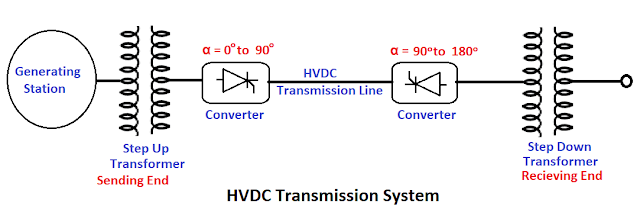HVDC Transmission
In
recent trends in power system power transmission through HVDC (High Voltage DC)
transmission line are also used. Dc transmission is an effective means to
improve system performance. In Dc Transmission power transferred from one
station to other station is governed only by the magnitude of terminal dc
voltage of two ends due to this reason controllability of HVDC power
transmission system is fast and sable. In India, the first 500 kV HVDC overhead
transmission line is 800 km long in between Rihand and Delhi. In India, the
highest transmission voltage level is reached 800kV. Dc transmission requires
converter at each end of the line. The sending end converter acts as a
rectifier converting AC into DC and the receiving end converter acts as an
inverter converting DC to AC.
Basic Principle of Operation of HVDC Transmission System
As we
know that the generation of power universally is AC in nature. So for Dc
transmission it requires to convert in DC. So we can say that DC Transmission
requires converter at each end of the line. The Sending end converter acts as a
rectifier converting Ac to Dc for transmission and the receiving end converter
acts as inverter converting Dc to AC for distribution. The sending end
converter (rectifier) is fed from an AC source through the Step-Up Transformer
and receiving end converter (inverter) feeds AC load through Step-down
Transformer. The output voltages of each end converters are controlled by varying
the firing angle of the thyristor valves of converter.
Comparison of HVAC and HVDC Transmission
HVAC Transmission | HVDC Transmission |
|---|---|
Three conductors are required for 3-phase power |
Only
two conductors are sufficient |
Number
of conductors requires is more and also number of towers required to carry
three conductors is more. So over long distance it is economically expensive. |
HVDC transmission system is economically cheaper for high power transmission above 800 MW as compared to HVAC transmission. |
In
HVAC Transmission voltage is constant current is variable depending on the
load. |
In
HVDC Transmission current flowing the line is constant voltage is variable. For maintaining constant current through the line current source converter are used. |
In
AC transmission system power transferred is governed by magnitude of voltages
as well as phase difference between voltages of each end. |
In HVDC transmission system power transferred is governed only by the voltages of each end. |
| Skin effect is present in HVAC transmission | There is no skin effect in HVDC transmission |
| Corona power loss is more because of frequency is 50Hz | Corona power loss is less |
| In HVAC transmission system, transmission line has inductive and capacitive components so it is required to supply reactive power to line. | In HVDC transmission system, transmission line has only resistive component so that there is no need of reactive power supply. |
| In HVAC transmission system, only possible to connect two systems operating at same frequency | In HVDC transmission system by using back to back connection it is possible to connect two different frequencies system. |
| Ferranti effect occurs. | There is on Ferranti Effect. |
| In HVAC transmission system, if fault occurs in one of the phase of three phase line then all the circuit breakers have to be open and isolate the faulty part. | In HVDC transmission system if fault occurs in one conductor then other conductor can supply half of the rated power by using bipolar link. |
Advantages of HVDC Transmission System
over HVAC Transmission System
There
are many advantages of DC transmission system over AC transmission which are listed
below.
- HVDC Transmission Systems are economical cheaper for long distance bulk power transmission over ac transmission because it requires only two conductors for power supply.
- In Dc transmission system ground return is possible.
- Losses are less in case of DC transmission system as compared to ac transmission system.
- There is no charging in case of DC transmission system because there is no reactive component in DC transmission.











No comments:
Post a Comment
Please feel free to provide suggestions and feedback and also do not hesitate to ask your question.